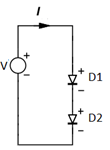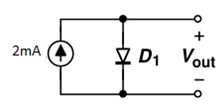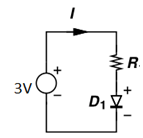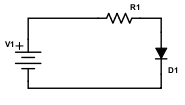This set of Analog Circuits Questions and Answers for Freshers focuses on “Characteristic Equation of Diode 2”.
1. Find the current I if both diodes are identical. Voltage V = 0.8V and let the reverse saturation current be 10-9A.

a) 4.8mA
b) 3.2mA
c) 2.5mA
d) 7mA
View Answer
Explanation: Since both diodes are identical VD = 0.8/2 = 0.4V
Equation for diode current

where I0 = reverse saturation current
η = ideality factor
VT = thermal voltage
V = applied voltage
Since in this question ideality factor is not mentioned it can be taken as one. Take VT as 0.026 which is the standard value.
Hence current through one diode is 10-9x(e0.4/0.026) = 4.8mA.
2. Find voltage VOUT if the reverse saturation current of the diode is 1.1×10-8A, the cut-in voltage of diode is 0.6V and assume the temperature as 25oC.

a) 0.235V
b) 0.3148V
c) 0.456V
d) 0.126V
View Answer
Explanation: Equation for diode current

where I0 = reverse saturation current
η = ideality factor
VT = thermal voltage
V = applied voltage
Since in this question ideality factor is not mentioned it can be taken as one. Take VT as its standard value 0.026V.
Voltage VD = ηVTln(I/IO + 1) = 1 x 0.0257ln (2 x 10-3/(1.1 x 10-9))+1) = 0.0257ln(1,818,182) = 0.3704 V.
3. The current Ix in the circuit is 1mA then find the voltage across diode D1. The resistance R1 is 1KΩ. Assume the reverse saturation current is 10-9A. Voltage across resistor in this condition was 0.4V. Take VT of diode as 0.026V.

a) 2.3mA
b) 3.2mA
c) 5.2mA
d) 4.6mA
View Answer
Explanation: Since voltage drop across diode is 0.4V current through resistor is 0.4/1k = 0.4mA
Current through diode

where I0 = reverse saturation current
η = ideality factor
VT = thermal voltage
V = applied voltage
Since ideality factor is not given take it as one.
Current through diode I = 10-9 x (e0.4/0.026) = 4.8mA
Total current = 4.8mA+0.4mA = 5.2mA.
4. Find the current Ix if the voltage across the diode is 0.5V. The reverse saturation current of diode 10-11A, the cut-in voltage of diode is 0.6V. Assume that the temperature at which diode operates is 25°C. The resistance R1=2KΩ.

a) 3.97mA
b) 4.51mA
c) 2.45mA
d) 3.05mA
View Answer
Explanation: Since voltage drop across diode is 0.5V current through resistor is 0.5/2k = 0.25mA
Current through diode

where I0 = reverse saturation current
η = ideality factor
VT = thermal voltage
V = applied voltage
Since ideality factor is not given take it as one.
Current through diode I = 10-11 x (e0.5/0.0257) = 2.8mA
Total current = 2.8mA + 0.25mA = 3.05mA.
5. If the current I is 2mA then find the temperature at which diode operates. The cut-in voltage of diode is 0.6V. The reverse saturation current of diode is 10-9A. Resistance R is 1.3KΩ.

a) 45.85°C
b) 50.47°C
c) 60.26°C
d) 56.89°C
View Answer
Explanation: Equation for diode current

where I0 = reverse saturation current
η = ideality factor
VT = thermal voltage
V = applied voltage
Since in this question ideality factor is not mentioned it can be taken as one.
VD = 3-(2mAx1.3k) = 0.4V

VT = T/11600
Thus Temperature, T = 11600×0.0275 = 319 Kelvin = 45.85°C.
6. If the temperature increases 10°C, the ratio of final reverse saturation current to initial reverse saturation current is _______
a) 1
b) 2
c) 1.5
d) 3
View Answer
Explanation: The equation relating final reverse saturation current (Io2 ) to initial reverse saturation current (Io1 ) is given by
Io2 = 2(∆T/10)Io1 Where ∆T is temperature change
Ratio will be 2(∆T/10) = 21 = 2.
7. The reverse saturation current of a diode at 25°C is 1.5 x 10-9A. What will be the reverse current at temperature 30°C?
a) 3 x 10-9A
b) 2 x 10-9A
c) 2.12 x 10-9A
d) 1.5 x 10-9A
View Answer
Explanation: The equation relating final reverse saturation current (Io2) to initial reverse saturation current (Io1) is given by
Io2 = 2(∆T/10)Io1 Where ∆T is temperature change
Here ∆T = 5, Therefore, Io2 = 25/10 Io1 = 1.414 x 1.5 x 10-9A = 2.121 x 10-9A.
8. How much times reverse saturation current will increase if temperature increases 15oC?
a) 2.52
b) 4.62
c) 4.12
d) 2.82
View Answer
Explanation: The equation relating final reverse saturation current (Io2) to initial reverse saturation current (Io1) is given by
Io2 = 2(∆T/10)Io1
Where ∆T is temperature change
Ratio is 215/10 = 2.82.
9. The input voltage V1 of the circuit the circuit is 2V and resistor has a resistance of 1KΩ. The cut-in voltage of the silicon diode is 0.7V and the reverse saturation current is 10-8A. The temperature at which diode operates is 30°C. The voltage across resistor when diode starts conducting is _________________

a) 0.7V
b) 1.3V
c) 0.306V
d) 1.7V
View Answer
Explanation: V1 = IR1 + VD
For silicon diode, cut-in voltage is 0.7V.
Hence IR1 = 2-0.7 = 1.3V
Drop across the resistor is 1.3V.
10. If V1 is 5V and resistance R1 is 5KΩ and the cut-in voltage of the diode is 0.7V, what will be the voltage Vout across the diode? Take reverse saturation current as 10-8A and operating temperature as 25°C.
a) 0V
b) -4.5V
c) -5V
d) -3.2V
View Answer
Explanation: Since diode is in reverse bias mode voltage across diode will be almost the same as the applied voltage. Since the current in the circuit is in micro amperes voltage drop at R1 is negligible.
Sanfoundry Global Education & Learning Series – Analog Circuits.
To practice all areas of Analog Circuits for Freshers, here is complete set of 1000+ Multiple Choice Questions and Answers.
If you find a mistake in question / option / answer, kindly take a screenshot and email to [email protected]
- Check Electrical & Electronics Engineering Books
- Practice Electrical & Electronics Engineering MCQs
- Practice Electrical Engineering MCQs
- Check Analog Electronics Books
- Apply for Electrical Engineering Internship
